Introduction
In the rapidly evolving landscape of cloud computing, understanding the intricacies of Software as a Service (SaaS) and Platform as a Service (PaaS) is essential for organizations striving to enhance operational efficiency and drive innovation. These two models not only offer distinct functionalities but also cater to varying business needs, making them integral to strategic decision-making.
As businesses increasingly migrate to cloud-based solutions, the implications of adopting SaaS or PaaS extend beyond mere technology choices; they encompass considerations of scalability, customization, and cost-effectiveness.
This article delves into the core concepts of SaaS and PaaS, explores their unique features and benefits, and provides insights into real-world applications, enabling organizations to make informed decisions that align with their long-term objectives in an increasingly digital economy.
Defining SaaS and PaaS: Core Concepts and Overview
Understanding what is SaaS and PaaS is essential as they represent two pivotal models within the realm of cloud computing, each serving unique purposes. Software as a Service allows individuals to use software programs online through a web browser, removing the requirement for installation or continuous upkeep. Prominent instances of software as a service include:
- Salesforce, which transforms customer relationship management
- Google Workspace, enabling effortless collaboration and productivity
Notably, over 46% of SaaS companies utilize multiple pricing pages to cater to different service types or market segments, reflecting the diverse needs of businesses. Conversely, platform as a service provides a thorough setting for developers to create, launch, and oversee software without the challenges of handling the foundational infrastructure. Prominent PaaS solutions include:
- Google App Engine, which simplifies application development
- Microsoft Azure App Services, known for its robust scalability and integration capabilities
The resilience of the software-as-a-service market is further illustrated by IDC's observation that 1 in 5 companies’ spending on these services was unaffected by the pandemic, highlighting its stability during challenging times. Additionally, as more than 60% of corporate data is now stored in the cloud, concerns about security are rising, underscoring the importance of robust data protection strategies in cloud environments. As organizations progressively move to cloud-based solutions, knowing what is SaaS and PaaS is essential for strategically utilizing software and platform services to improve operational efficiency and innovation.
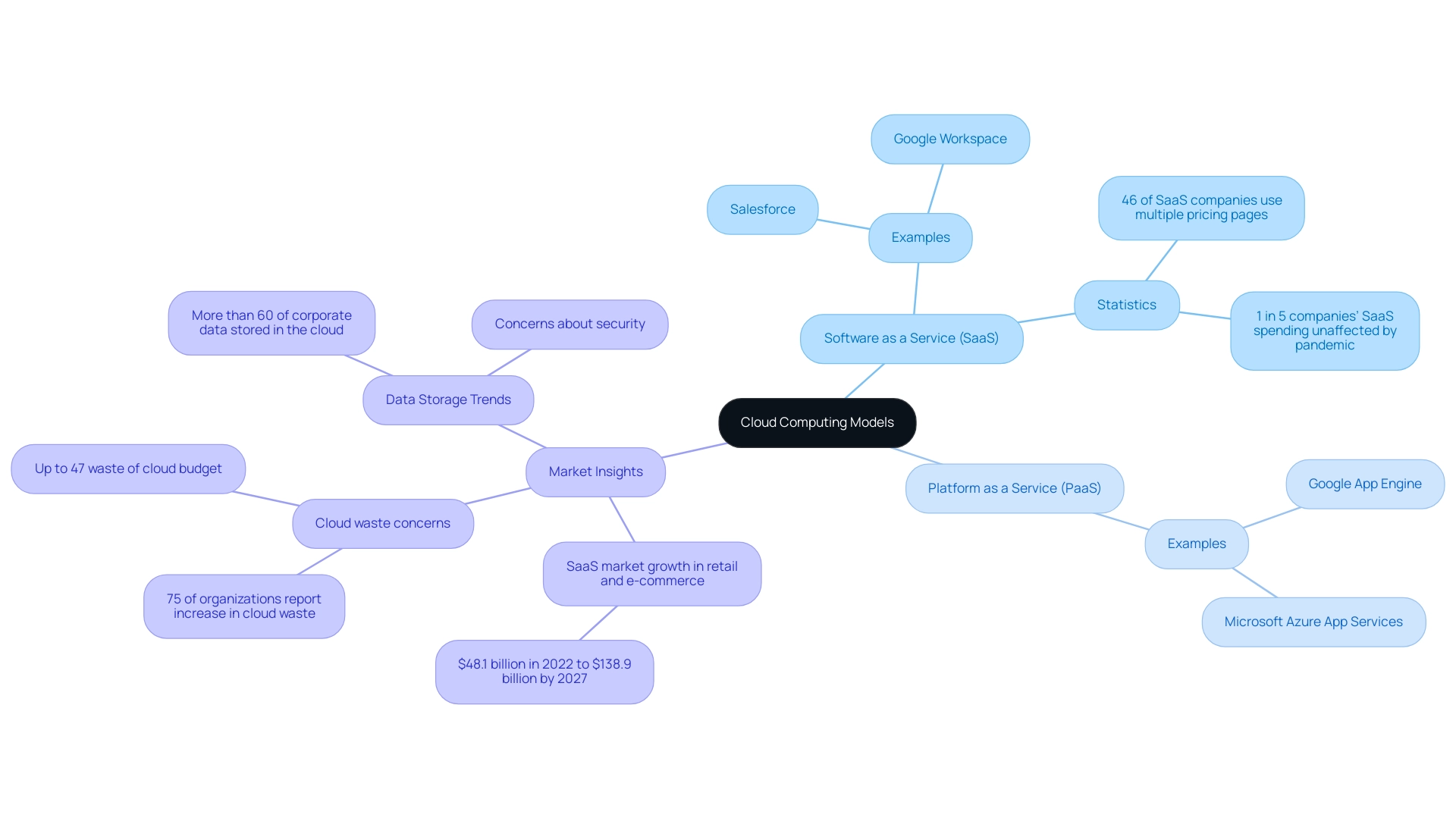
Key Differences Between SaaS and PaaS: Understanding Their Unique Features
The difference in functionalities and intended users highlights what is SaaS and PaaS. To understand what is SaaS and PaaS:
- Software as a Service (SaaS) is customized for end-users wanting instant access to pre-built software solutions.
- Platform as a Service (PaaS) is created for developers requiring a strong environment to construct, launch, and oversee software.
Significantly, software services frequently offer restricted customization choices, which can affect their flexibility to particular business requirements.
In contrast, platform-as-a-service offers extensive tools and services that enable the development of customized software, allowing developers to create solutions that fit unique organizational needs. For instance:
- A company may utilize software-as-a-service for customer relationship management (CRM) systems to streamline user interactions.
- Developers might opt for platform-as-a-service to create a specialized application that addresses specific operational challenges.
Furthermore, the cloud landscape is significant, with AWS accounting for 32% of global cloud spending in Q3 2022, highlighting the importance of these services in current market dynamics.
Additionally, as noted by Vertice, the software-as-a-service inflation rate is almost four times higher than the standard market inflation rate, indicating economic pressures that organizations must consider. Real-world applications of these models are evident in case studies like Drift, which utilized CloudZero to optimize their software-as-a-service costs, reportedly saving over $2.4 million in annual AWS spending. This clear differentiation underlines the evolving landscape of cloud services, where organizations must evaluate their specific needs and capabilities to make informed decisions.
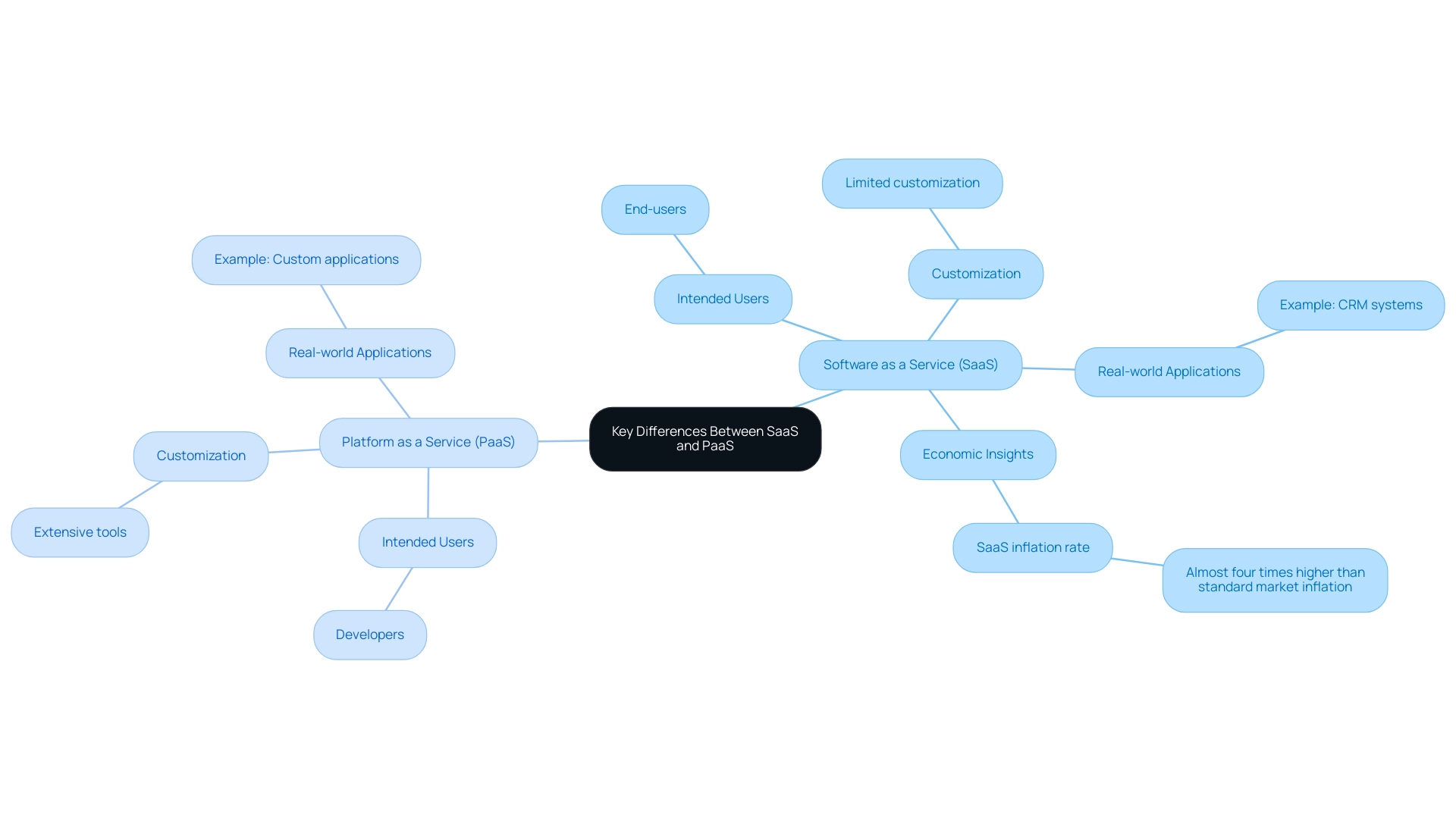
Pros and Cons of SaaS and PaaS: Weighing the Benefits and Drawbacks
Organizations must thoughtfully evaluate what is SaaS and PaaS since each offers unique benefits and obstacles. On the one hand, Software as a Service is attractive because of its lower initial expenses, easy-to-navigate interfaces, and automatic updates, which together lessen IT overhead. A significant benefit of software as a service is its speed; organizations using these solutions report the capability to launch new services or products up to 40% quicker, a critical factor in today’s fast-paced market.
Businesses utilizing software as a service have reported that they can launch new offerings or products up to 40% quicker, highlighting the competitive advantage it offers. However, businesses must also be wary of potential downsides, such as vendor lock-in and limited customization options, which can restrict flexibility in adapting the software to specific needs.
Conversely, Platform as a Service (PaaS) offers developers robust tools for creating highly customizable applications while simplifying infrastructure management. This model is particularly advantageous for organizations looking to innovate rapidly.
However, it demands certain levels of technical expertise and might result in higher costs if not managed effectively. Recent studies indicate that 46% of SaaS companies utilize multiple pricing pages targeted at different service types or market segments, highlighting the importance of strategic pricing and marketing approaches in leveraging SaaS effectively.
Moreover, half of surveyed businesses recognize online computing as a vital component of their data protection strategy, with many adopting it for disaster recovery. This statistic highlights the essential role of online solutions in protecting business data. The competitive environment is similarly evolving; for instance, Google Cloud's IaaS offering has significantly outpaced rivals, reflecting a growing market share that underscores the importance of IaaS in overall strategy.
This dynamic illustrates the necessity for businesses to weigh the pros and cons of both what is SaaS and PaaS solutions in 2024, ensuring that their cloud strategies align with both immediate needs and long-term objectives.
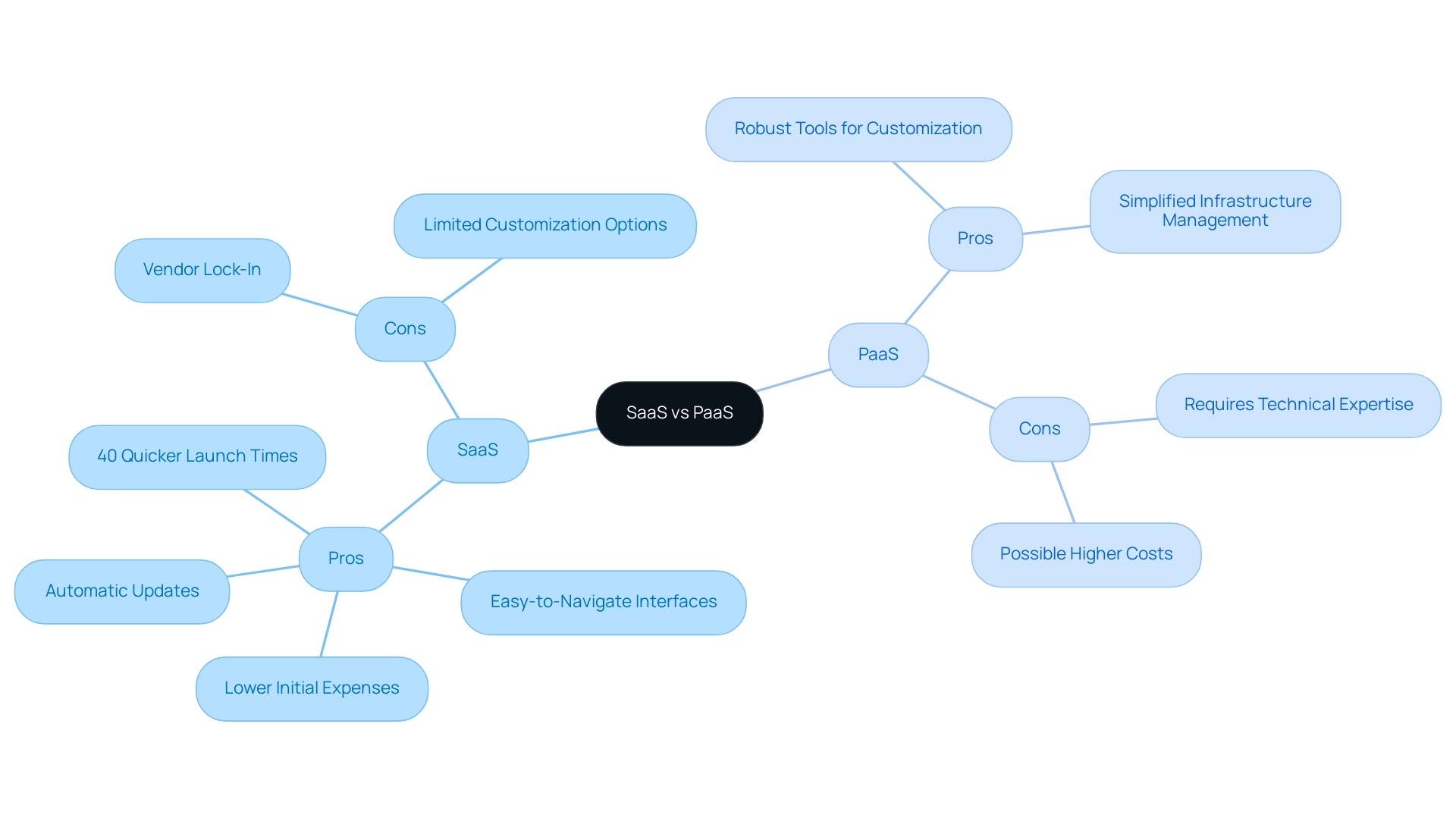
Real-World Applications: Use Cases for SaaS and PaaS
Understanding what is SaaS and PaaS is crucial as they are progressively essential to diverse sectors, promoting improved productivity and operational effectiveness. For instance, in customer relationship management (CRM), platforms such as Salesforce illustrate how software as a service can change customer interactions. Businesses leveraging Salesforce can manage customer relationships more effectively, resulting in improved service delivery and customer satisfaction.
Furthermore, PaaS solutions, such as Heroku, play a pivotal role in software development, allowing developers to build, test, and deploy applications with remarkable ease. This capability accelerates the development cycle, with companies utilizing SaaS reportedly deploying new services or products up to 40% faster. However, as companies' spending on remote resources increases, so does their waste in this area, as noted by StormForge, highlighting a significant challenge in optimizing these resources.
Furthermore, the increasing trend of online storage is emphasized by the fact that over 60% of corporate data is now stored remotely, raising concerns about security among analysts and necessitating robust data protection strategies. As organizations increasingly rely on these cloud service models, the resulting innovations and efficiencies are crucial for maintaining a competitive edge in today’s market.
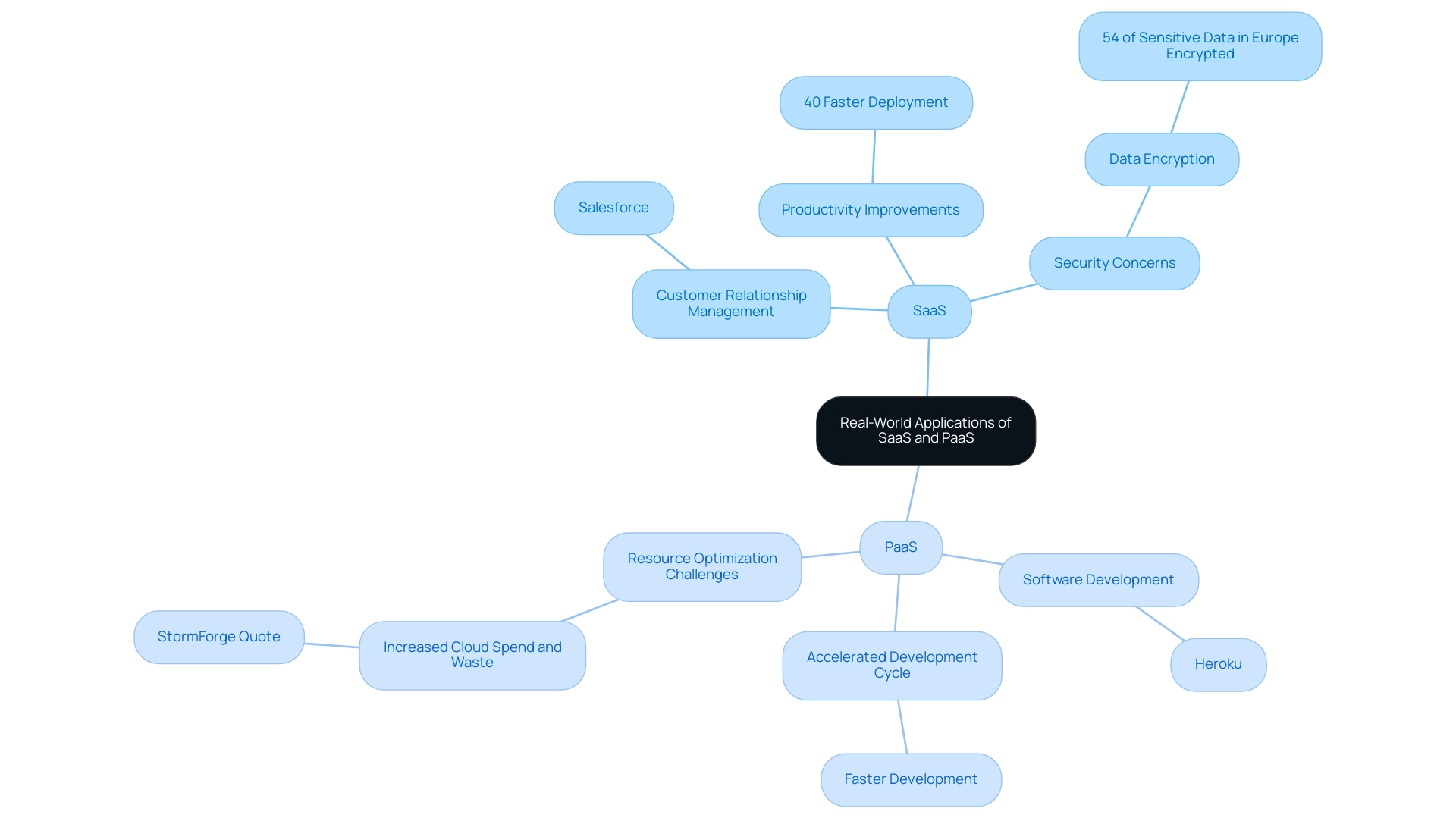
Choosing Between SaaS and PaaS: Key Considerations for Decision-Making
Organizations face critical decisions when choosing between different service models, particularly in understanding what is SaaS and PaaS, necessitating a careful evaluation of several key factors. Scalability stands out as a paramount consideration; for businesses anticipating rapid growth, platform-as-a-service offers the necessary flexibility to adapt and evolve. Customization needs also play a significant role; if unique functionality is essential, platform as a service is often the preferable choice due to its capacity for tailored development.
Furthermore, the technical expertise of the team should not be overlooked; companies with skilled developers may reap greater benefits from PaaS, while those seeking more straightforward, ready-to-use solutions may find alternative software to be a more suitable option. Current trends in technology highlight what is SaaS and PaaS, such as the rise of generative AI and workflow automation, further emphasizing the need for organizations to stay abreast of advancements that can enhance their operations. According to a recent survey, waste in this technology could reach as high as 47% of a budget, underscoring the importance of making informed strategic decisions.
For instance, Drift successfully reduced its annual expenses for online services by $2.4 million through effective cost management strategies, illustrating the tangible benefits of thoughtful decision-making. By meticulously weighing these considerations, organizations can align their service selection with their long-term objectives, ultimately fostering operational efficiency and enhancing overall performance in an increasingly digital landscape. As Cody Slingerland noted, "Combined, these two regions account for 82% of the world’s cloud computing," highlighting the critical role these services play in modern business infrastructure.
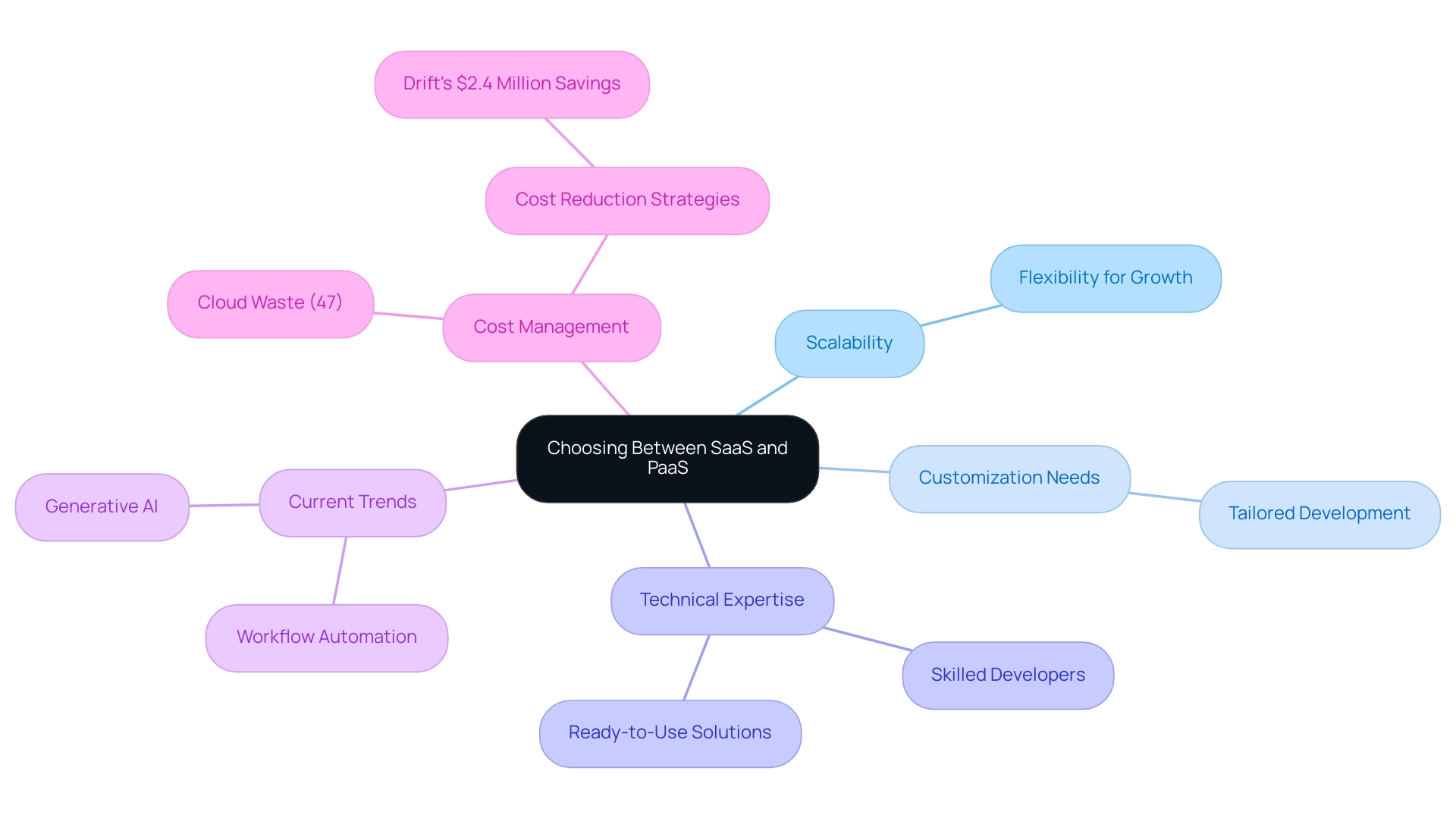
Conclusion
The exploration of Software as a Service (SaaS) and Platform as a Service (PaaS) reveals their critical roles in the contemporary cloud computing landscape. SaaS provides immediate access to software applications, enhancing user productivity while minimizing maintenance efforts. In contrast, PaaS empowers developers with a robust environment for creating tailored applications, allowing for significant customization and innovation. Both models present unique advantages and challenges that organizations must consider, such as cost implications, scalability, and the technical expertise required for effective implementation.
As businesses navigate their cloud strategies, the importance of evaluating these models in relation to specific operational needs cannot be overstated. The distinction between SaaS and PaaS is not merely a matter of preference; it is a strategic decision that influences an organization’s ability to adapt, innovate, and thrive in an increasingly digital economy. Real-world applications highlight the transformative potential of both services, underscoring their capacity to drive efficiency and competitive advantage.
Ultimately, the decision to adopt SaaS or PaaS should align with an organization's long-term goals and immediate requirements. By carefully weighing the pros and cons, and staying attuned to evolving market trends, organizations can leverage these cloud solutions to foster operational excellence and support sustainable growth in a rapidly changing technological landscape. The journey into cloud computing is not just about technology; it is about making informed choices that position businesses for future success.




